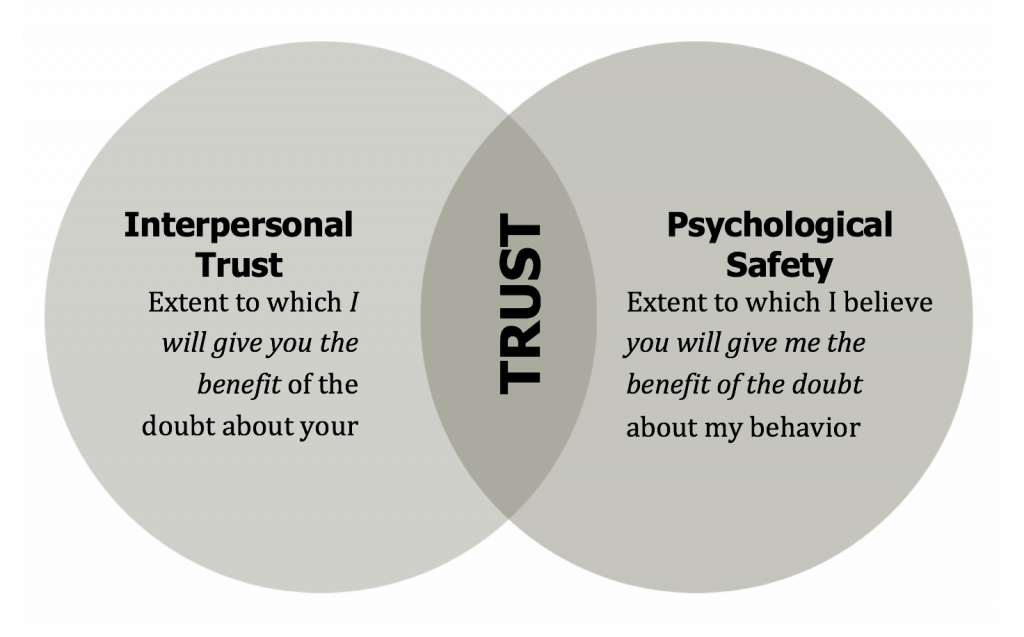The authors have uncovered tried-and-true ways to build high psychological safety and trust cultures in workplace teams. The rewards? Growth, engagement, purpose, and performance.
By Kenneth M. Nowack, Ph.D. and Paul J. Zak, Ph.D.
Teams are increasingly commonplace in organizations, with leadership shifting away from a focus on individual results and toward team effectiveness and performance. Indeed, a collective is typically stronger than the individual because of the diversity of experiences, skills, knowledge, and capabilities, allowing teams to work on more complex tasks and assignments.
Although no two teams are the same, a team’s purpose, mission, and goals can be used to identify the type of team. Commonly, teams are composed of individuals in “arranged marriages” for specific periods of time and are expected to collaborate, share information, learn, innovate, and produce high-quality outcomes and results.
Teams are made up of human beings and will therefore face tension and conflict. Direct, honest, and authentic communication is often required to resolve and manage interpersonal disagreements.
Challenging conversations effectively reduce conflict when team members sense they’re in a safe environment and feel free to speak openly. Teams that possess two key aspects of their culture—interpersonal trust and psychological safety—are much more likely to be effective and reach performance objectives than are teams without these.
The neuroscience behind these two components of high-performance teams and the underlying causes of in-group versus out-group competition has been established over the past decade.
What Exactly Is Trust?
Interpersonal trust and psychological safety can be conceptualized as mirror images of social interactions associated with individual, team, and organizational behavior (see Figure 1).
Is it possible that when we interact with others and perceive that they’re capable, caring, ethical, and predictably consistent in their behavior that some type of “switch” in the brain turns on to signify we should trust them and feel safe with others?
Figure 1: Interpersonal Trust & Psychological Safety

A turning point in the research on trust was the discovery of the role of a neurochemical called oxytocin that’s part of the mammalian attachment system.
Studies in the past 15 years have shown that oxytocin facilitates prosocial behavior even among strangers. Interpersonal trust can be defined as the extent to which we hold positive expectations of others in the face of uncertainty about their motives and yet are willing to allow ourselves to be vulnerable.
For over 20 years, one of us (Zak) and colleagues have been exploring the science underlying interpersonal trust and initially used a cooperative decisions task known as the trust game. In the trust game, participants are placed into anonymous dyads and randomly assigned to the roles of decision-maker 1 (DM1) and decision-maker 2 (DM2).
Both DMs are allocated money from the researchers as compensation for their time. Importantly, for a study of trust, there is no deception in this experiment and DMs cannot contact each other before, during, or after decisions are made. All interactions take place via a computer while participants sit at desks with privacy dividers.
After identical instruction, DM1 is prompted via software to send any amount (including zero) of his or her money to the DM2 in his or her dyad. Participants know that whatever is sent comes out of DM1’s account and is tripled in DM2’s account.
The software then informs DM2 of the tripled amount of money he or she was sent by DM1 and then prompts DM2 to send some amount back to DM1 (including zero). All participants are informed that transfers from DM2 to DM1 are not multiplied and constitute a dollar-for-dollar allocation out of DM2’s account and into DM1’s account.
This research approach allows for the measurement of both trust (DM1 to DM2 transfer) and trustworthiness (DM2 to DM1 return transfer). Zak’s innovation was to obtain blood samples before decisions to assess possible changes in oxytocin. These researchers found that the receipt of money denoting trust, but not money in general, causes the brain to synthesize oxytocin.
Further and importantly, the amount of oxytocin produced predicts trustworthiness—the return of money to the DM1 who had initiated trust. This shows that the intention behind someone’s actions is important.
This research team also demonstrated the causal effect of oxytocin on trust by safely infusing synthetic oxytocin into people’s brains through their noses. Those given synthetic oxytocin, compared to participants who received a placebo, trusted strangers with 17 percent more money and were twice as likely to show maximal trust by sending all their money to another person.
Outside of our conscious awareness, our brains continuously seek the right balance between being wary of strangers and interacting with them. Cooperating with others puts us at risk of exploitation, but it also allows us to derive value from such interactions including friendships, romantic partnerships, or agreeing to work together on a team project composed of diverse individuals.
Oxytocin signals that a person is psychologically safe to be around by reducing the natural wariness we have around those who are different from us (e.g., race, age, gender).
Subsequent research by Zak has shown that oxytocin directly influences psychological safety and interpersonal trust by increasing our emotional connection to others—i.e., by increasing empathy.
When our empathic concern is enhanced, we’re motivated to help others—except when we aren’t. In fact, when individuals who possess some specific personality disorders (social anxiety, trait aggressiveness, and borderline personality) are given extraneous oxytocin it can sometimes result in enhanced competition, in-group bias, and even greater distrust of others.
The Benefits of Psychological Safety
There is strong evidence that successful teams possess psychological safety—a perception that others on the team will give you the benefit of the doubt about your behavior.
This safety allows for a sense of confidence that you can challenge the status quo and express your thoughts and opinions without reservation, particularly in the face of opposition from others.
The concept of psychological safety, although popular today, is decades old. In the late 1950s, psychologist Will Schutz first described his Fundamental Interpersonal Relations Orientation (FIRO) theory to explain social interactions in groups and teams.
Although he didn’t use the term psychological safety, one of his main concepts was the idea that a fundamental interpersonal need was for openness and safety to express opinions, thoughts, and ideas with others.
In 1965, Warren Bennis and Ed Schein wrote that psychological safety reduces defensiveness and makes people in teams feel more secure, improving a team’s performance. In the 1990s, William Kahn studied members of an architectural firm and counselors employed in summer camps and showed how psychological safety was linked to personal engagement.
Amy Edmondson at Harvard University was one of the first to create an academic measure of psychological safety, and her numerous publications have consistently demonstrated that people in safe cultures are more likely to speak up, share knowledge, demonstrate greater cooperation with each other, and that these behaviors are associated with important team outcomes (learning, innovation, engagement, performance).
This research was confirmed by analysts at Google, who interviewed more than 200 team members and quantified more than 250 attributes of over 180 active teams. The Google project revealed that how team members interacted, organized their work, and held beliefs about how much their work mattered were key predictors of high performance.
The most important performance predictor was psychological safety—the extent to which team members reported feeling safe to be vulnerable and authentic with others allowing them to take greater risks.
4 Pillars of Psychological Safety and Interpersonal Trust
Harvard Business School professor Amy Cuddy has been studying first impressions alongside fellow psychologists Susan Fiske and Peter Glick for more than 15 years, and has discovered some important patterns in these interactions.
Two key dimensions that define to what extent a person respects and will trust another: competence and warmth/trustworthiness. Of the two, trustworthiness appears to be the most important factor in how we actually size up and relate to others.
Research from Roger Mayer, a professor of management, innovation, and entrepreneurship at North Carolina State University, along with Professor David Schoolman from Purdue University, found two other important factors that influence our appraisal of others: the perceived integrity/honesty of the individual and his or her expected reliability or consistency of behavior toward us and others.
In our own research and work, we refer to four independent pillars of psychological safety and interpersonal trust (capability, consistency, caring, and candor/authenticity), all enabled by the brain’s release of oxytocin.
We’ve shown that people assess others using the four pillars, and if one is absent, it reduces the willingness to cooperate with others (interpersonal trust) and lowers the expectation that others will show support if one shares new ideas, knowledge, or challenges the status quo (psychological safety).
Figure 2: Cognitive and Affective Trust

Three other factors also play an important role in psychological safety and interpersonal trust in teams and organizations: culture, hormones, and genetics.
Although trust and psychological safety are important for team functioning, it develops differently and sometimes less fluidly in some global and multi-cultural teams.
Whereas Americans develop trust based on relationships and separate cognitive and affective aspects, for example, Chinese leaders in one study based trust more on economic factors and seem to combine both cognitive and affective trust.
The differences in establishing trust may also depend on cultural values like collectivism versus independence or the accepted degree of hierarchy (power distance).
In addition to culture, hormone levels also affect group performance. Modupe Akinola and colleagues at Columbia Business School discovered that testosterone levels of individual team members predict how successful the team may be.
They found that in diverse groups (culture, background, age, and so on), high testosterone measured via saliva tests was associated with poor performance by, apparently, enhancing conflict and competition.
However, high group testosterone levels were advantageous in homogenous groups that lacked cultural diversity. Exercises that build relationships in diverse groups may be able to reduce in-group competition and focus the high-energy of testosterone toward meeting the group’s objectives.
Finally, it’s also known that two genes, CD38 and CD157, regulate the release of oxytocin.
Anne Chong and colleagues at the National University of Singapore studied the social skills of 1,300 healthy young Chinese adults. They found that individuals with higher gene expressions of CD38 and variations in CD157 displayed greater sociality (preferring activities involving other people over being alone) and better communication and empathy-related skills, compared with the other participants.
Altogether, the higher expression of the CD38 gene and differences in the CD157 gene sequence explained 14 percent of the differences in social skills among the participants.
All of these studies illustrate how psychological safety and interpersonal trust is influenced by both nature and nurture.
How Our Brains See ‘Us’ Versus ‘Them’
When your brain produces oxytocin while interacting with others, you’re motivated to cooperate and collaborate with them.
Brain imaging experiments have shown that infusing people with oxytocin results in a marked reduction in fear-associated, brain-activity-enhancing psychological safety. The more oxytocin your brain makes, the more you feel empathy toward others, connecting you emotionally and nudging you to invest in helping them.
This explains how we’re able to cooperate with others we view as trustworthy and safe, yet our survival instinct means we also unconsciously classify some people as members of an out-group.
When people are primed to view others as “different,” or are told they shouldn’t cooperate with them, psychological safety is diminished and team performance follows.
But, recent research at Zak’s labs has shown that even taking a few minutes to get to know others or taking a walk together can induce the brain to make oxytocin. This melts the self-other divide and both sharing and teamwork follow.
It doesn’t take long to create a team culture to stimulate oxytocin release and improve interpersonal trust and group performance. Interestingly, the observed in-group bias at a neural level actually weakens when people have lived in diverse cultures or worked in highly diverse teams.
How to Enhance High Psychological Safety & Interpersonal Trust
Neuroscience research helps us identify ways to more effectively work in diverse teams, minimize unconscious bias, and enhance safety, trust, and collaboration in organizations.
Business leaders should care about the neuroscience of diversity because the mind processes information so rapidly that the causal networks in the brain are best understood by measuring neural activity at the millisecond frequency.
For example, one study Zak did at an innovative technology company found that when employees in groups of four discussed their company’s values, oxytocin spiked, productivity went up, and the stress of work was shed twice as fast than when employee groups discussed a newspaper article about technology trends.
This study showed very clearly that culture matters and cultural values and norms should be defined, mutually agreed upon, and reinforced often. Business leaders should also work to improve culture by knowing how it affects brain and behavior.
In fact, a recent study of ours analyzed a representative sample of working adults in the United States and found that working in companies in the top quartile of trust—compared to those in the lowest quartile—have 106 percent more energy at work.
In addition, they’re 76 percent more engaged and 50 percent more productive. What’s more, employees reported 40 percent less job burnout and even took 13 percent fewer sick days. Those privileged to work in high-trust companies were also 29 percent more satisfied with their lives outside of work.
Creating a culture of trust will improve the triple bottom line: Psychological safety and interpersonal trust are good for employees, enhance organizational performance, and strengthen communities by creating happier and healthier parents, partners, and citizens.
Companies focused on building a high-trust culture will engender a climate of safety associated with professional growth, engagement, purpose, and performance as they serve their clients and colleagues.
Kenneth M. Nowack, Ph.D., is a licensed psychologist and cofounder of Ofactor. He received his doctorate degree in Counseling Psychology from the University of California, Los Angeles and has published extensively in the areas of 360-degree feedback, assessment, health psychology, and behavioral medicine.
Paul J. Zak, Ph.D., founding director of the Center for Neuroeconomics Studies and professor of economics, psychology, and management at Claremont University, is a leading expert and scientist, author, and speaker. He is credited with the first published use of the term “neuroeconomics” and has been a vanguard in this new discipline.


